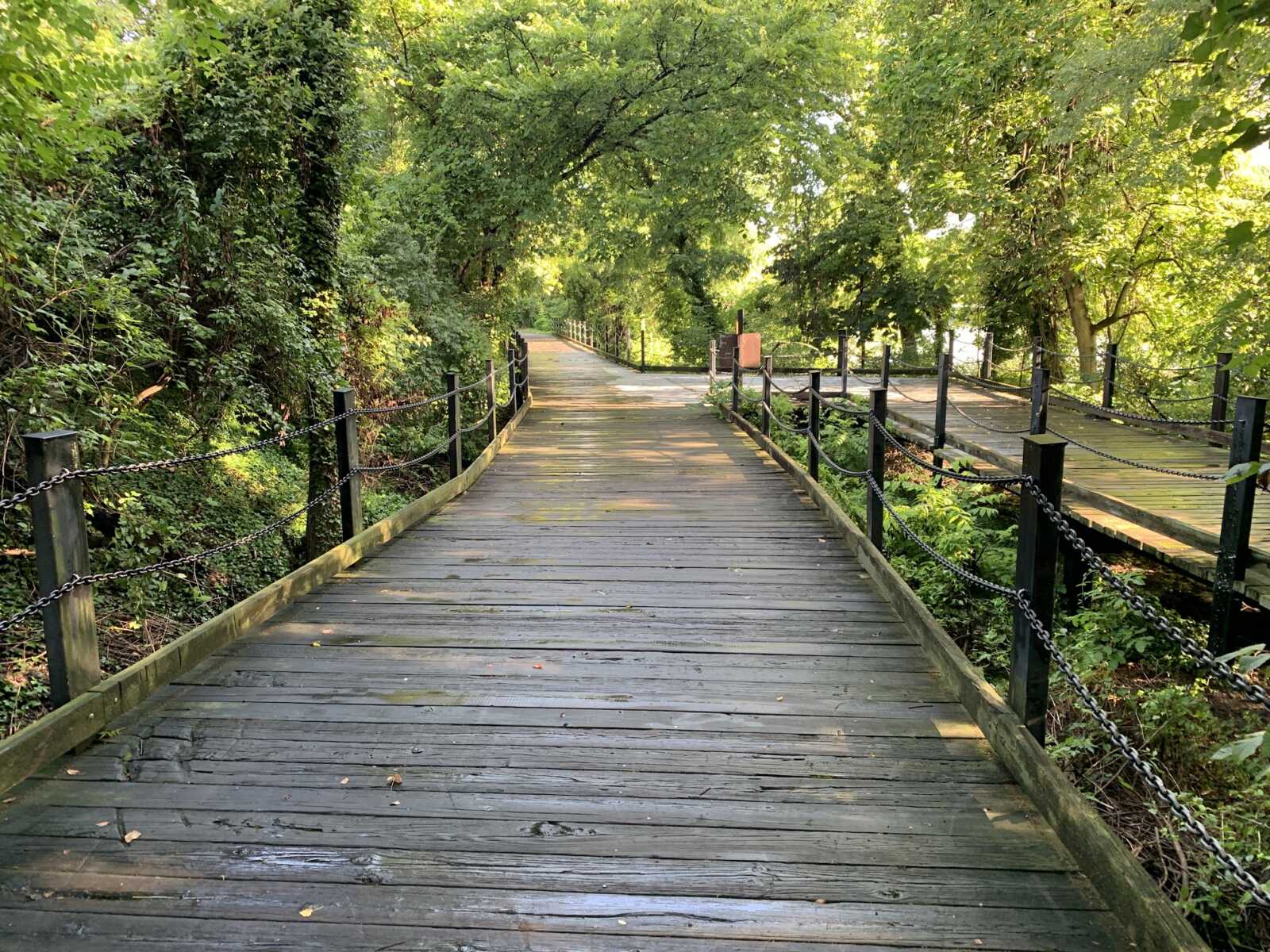
Federal funding is on track to bring more housing for many of the county’s most vulnerable residents as well as trail improvements and new playground equipment.
The U.S. House of Representatives approved on Wednesday $5.9 million in funding for Arlington initiatives in its annual budget. A little more than half of that funding — $3.3 million — is for housing for low-income residents, domestic violence survivors and chronically unsheltered people.
“Affordable housing is a major need in Northern Virginia, and I am thrilled that I could help address this issue by securing federal funds for housing projects in all of the jurisdictions I represent: Arlington, Alexandria, Falls Church, and Fairfax County,” Rep. Don Beyer (D) said in a press release.
The rest of the House-approved funds are for $2 million total in improvements to the Mount Vernon Trial and Arlington Boulevard Trail, plus $500,000 for upgrades to Monroe Park Playground.
The funding, according to the release, is expected to pass in the Senate, which has until the end of today (Friday) to pass a budget and prevent a partial government shutdown.
Of the $5.9 million, the biggest-ticket allocation is $1.5 million for Doorways, Arlington’s only service provider for survivors of domestic and sexual violence. The expenditure, which will be matched with private funds, is intended to help Doorways acquire apartments to provide shelter and longer-term housing for survivors and rely less on hotel rooms.
In a similar vein, $1.3 million is meant to allow PathForward to purchase an apartment building that houses people who have repeatedly fallen into homelessness. Leaders of both nonprofits previously told ARLnow they are seeing an increased demand for their emergency services but inflation pressures are straining their ability to provide them.
Lastly, another $500,000 would support efforts to convert the Melwood property at 750 23rd Street S., near Crystal City, into 104 units of affordable housing.
Arlington trail and park upgrades may also get a financial windfall.
Five miles of the Mount Vernon Trail running along the Potomac River between Rosslyn and Tide Lock Park in Alexandria are on track to receive $1.3 million. This funding would go toward widening the trail, which is one of the most popular commuter and recreational routes in the region, as well as realigning portions of it.
Another $720,000 would go toward safety improvements on Arlington Boulevard Trail, where a narrow sidewalk is directly adjacent to the road’s on- and off-ramp.
Finally, $500,000 could replace play equipment and improve amenities at Monroe Park Playground, a 23-year-old recreation site that is due for renovations.
“Even in the minority amid a divided and chaotic Congress, I am laser focused on helping my constituents and benefitting Northern Virginia,” Beyer said.

The Arlington County Board is considering a potential property tax hike that could be even higher than what County Manager Mark Schwartz proposed.
Board members yesterday (Tuesday) voted 5-0 to advertise hearings on a maximum property tax rate of $1.038 per $100 of assessed value, a 2.5 cent increase from 2023. That is 1 cent higher than the increase of 1.5 cents that Schwartz proposed in his $1.62 billion budget proposal for Fiscal Year 2025.
County Board Chair Libby Garvey said she hopes to whittle down the possible tax hike during upcoming budget discussions. She introduced the motion to add a penny because Arlington Public Schools still does not know how much state funding it will receive.
In the worst-case scenario, Garvey said APS could have a substantial budget shortfall in the upcoming fiscal year.
“There’s a lot of uncertainty this year when it comes to budgeting,” Garvey said in a statement. “I’m very concerned about our schools and whether the state will do the right thing and provide the level of expected funding — or if the state will leave APS short millions on top of the cuts already made. Hopefully, the state will come through, and this extra penny will not be needed.”
Schwartz’s proposed budget already includes $10 million in additional funding to APS to help close a projected $30-35 million budget gap. Superintendent Francisco Durán is scheduled to present APS’s proposed 2025 budget tomorrow (Thursday).
If adopted in April, a 2.5-cent increase would cause the typical Arlington homeowner to pay an additional $472 in taxes, based on the average home value of $824,700, per a county press release. That’s in addition to rising fees for stormwater management, waste collection and other services.
In total, the average Arlington homeowner would see their total fees and taxes increase by $582 if the Board adopts the 2.5-cent tax rate increase, the county says.
Arlington County held its property tax rate steady during the pandemic, though rising property assessments caused the average homeowner to pay some 4-5% more annually anyway.
Board members noted that a higher advertised tax rate will allow for more flexibility in discussions about funding for housing, mental health and public safety, with a focus on the county’s detention facility.
“I think there’s just too much unknown at this particular moment for us to box ourselves in,” said Board member Maureen Coffey.
The Board can still choose to adopt a lower rate, but not a higher one.
Rising taxes and property values are also expected to put upward pressure on rents, as apartment assessments are expected to increase by an average of 6.6%, or $215 per unit.
The proposed $1.62 billion budget would eliminate 33 county staff positions — many that are currently vacant — in various departments, saving about $10 million, according to Schwartz. The budget includes a 4.75% salary increase for all non-union county employees.
There is also additional funding for teen programs intended to help combat the teen opioid crisis, mental health and substance abuse programs, affordable housing and eviction prevention and environmental initiatives.
Arlington’s police and fire unions have called for further tax increases to fund raises for first responders and reverse staffing declines, particularly in the police department.
The Board will conduct a series of budget work sessions in March, followed by a pair of public hearings on the budget and the tax rate on April 2 and 4, respectively. The final budget adoption vote is scheduled for Saturday, April 20.
State-funded safety improvements to the Mount Vernon Trail are one step closer to getting underway.
The Arlington County Board is set to review on Saturday a memorandum of agreement with the Virginia Department of Transportation, the National Park Service and the Federal Highway Administration governing the roles of the respective agencies throughout the project.
Some five miles of trail between Rosslyn and Tide Lock Park in Alexandria are set to be widened so that users have 5.5 feet of space in each direction, as opposed to the current 3.5 feet. One bridge near Theodore Roosevelt Island, the infamous wood plank Trollheim Bridge, and two bridges in Alexandria will also be rebuilt and widened.
Lastly, the S-curve at Daingerfield Island and four intersections — near Theodore Roosevelt Island and the Humpback Bridge, Crystal City connector and Four Mile Run trails — will be realigned to reduce conflicts. Construction is set to start in the 2026-27 fiscal year.
Four years ago this May, NPS, which administers the Mount Vernon Trail, released a study detailing its current conditions and recommending substantial upgrades. The study found that pedestrian and cyclist conflicts are significant along narrow and congested portions of the trail through Arlington County, particularly near Rosslyn and Crystal City.
The study also determined the intersection with the Four Mile Run Trail has high crash potential and recommended straightening the sharp S-curve at Daingerfield Island.
A few months later, the Arlington County Board gave the green light to apply for state funding for some these recommended upgrades. In 2021, the state awarded the project $29 million from its discretionary transportation capital funding program.
NPS will chip in $4 million to cover the difference between estimated project costs and the state’s allocation and will cover any budget overages. Already, it has conducted public engagement on the project and will continue to do so as the project progresses through the conclusion of design and into construction, the county report says.
The agreement set for review this weekend must be approved for NPS to access the funding, according to the county.
As part of the agreement, Arlington County will appoint a project manager tasked with making sure the project stays within the scope of what the state approved. The county will also approve the final designs, which are nearly 30% complete so far.
Additionally, the County Board will review a separate agreement that includes Alexandria, pertaining to the trail portions that fall within its city limits.
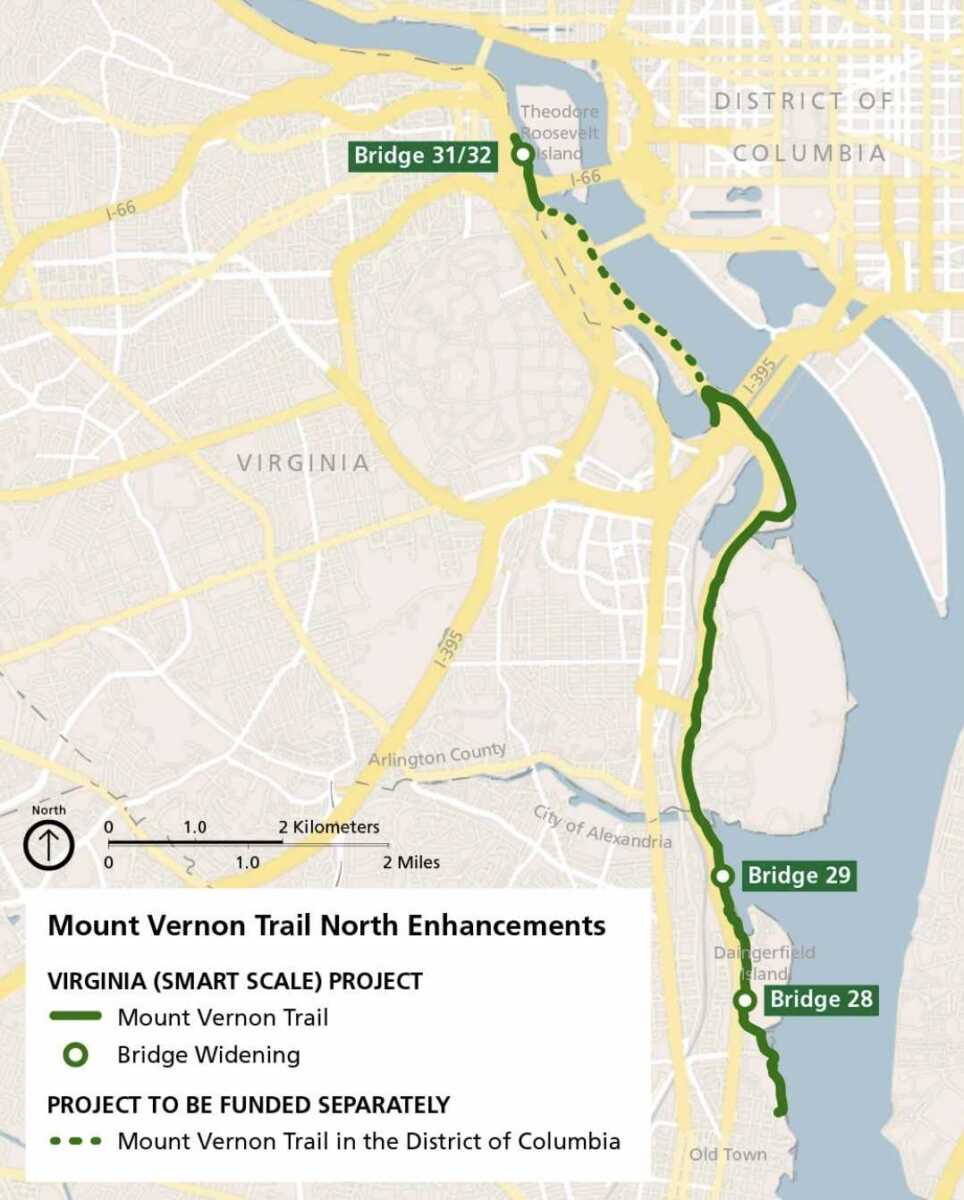

An uptick in childcare centers in Arlington has made a dent in the local care shortage, according to new county data.
Since 2017, the number of childcare center slots increased by 47%, or 1,690 slots. That may be good news for tackling low availability in Arlington — which stands out among Northern Virginia neighbors for how few slots it has — but one shortage remains.
The county tells ARLnow that too few providers today accept state subsidies, affecting how many low-income families can access high-quality childcare.
“Although the county has seen a substantial increase in child care center slots and a slight increase in the number of family day care home slots in Arlington since December 2017, there has only been a modest increase in the number of child care providers accepting the Virginia Child Care Subsidy,” county spokesman Ryan Hudson said in a statement.
“This modest increase has most definitely not kept pace with the increase in the number of Virginia Child Care Subsidy Program participants during the same timeframe,” he continued.
Arlington County partially attributes the uptick in daycare centers to zoning code and review process reforms to make it easier to approve private child-care services. Those improvements, used by all county planners today, “have helped child care providers and increased child care availability in Arlington,” the county says.
But the uptick in slots pales in comparison to the number of families participating in a state subsidy program, who are vying for a small pool of slots, as not all providers accept such subsidies. Those that do typically reserve few slots for participating families.
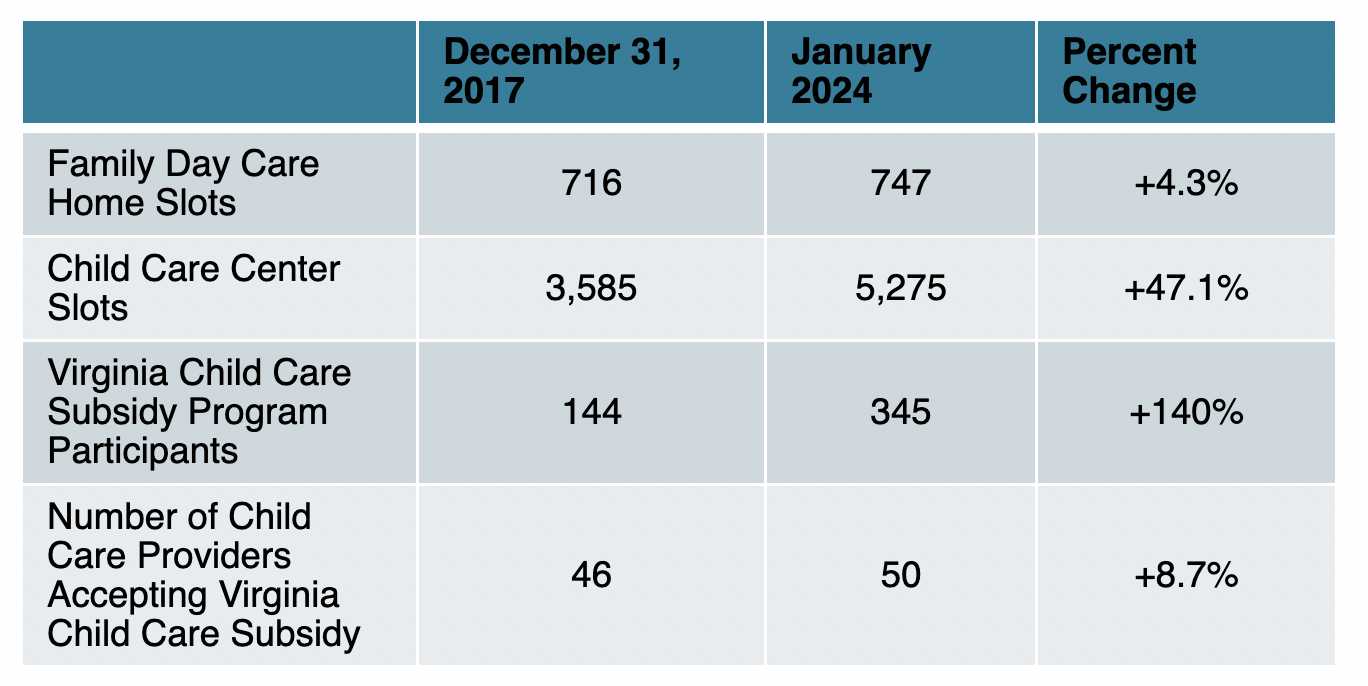
This is not a new problem for Arlington or Virginia, which recently ranked in the bottom half of American states and territories for the number of providers that accept subsidies.
Seven years ago, the county found that providers could serve half of Arlingtonians under 5 years old, with childcare centers making up half of Arlington’s overall capacity. Subsidized slots made up 2-23% of that capacity, varying by provider, compared to the 33% subsidy acceptance rate on average for home-based daycares.
That discrepancy is still true today and the providers cite several reasons for not participating.
These include “the complicated nature of reimbursement and reporting requirements, the cost of child care being much greater than the Virginia Child Care Subsidy Program’s Maximum Reimbursement Rates, and the fact that there is no operational need to accept the Virginia Child Care Subsidy when child care programs are already full and operating with waitlists,” Hudson said.
Arlington County is looking to help alleviate these concerns with a new program backed by $5 million in local funding. In December, it issued a “Notice of Funding Availability,” or NOFA, advertising $4.5 million available to applicants who bring forward “capital-oriented proposals that expand access to affordable, quality child care on a sustainable, multi-year basis.”
“Proposals should increase affordability in exchange for assistance with capital costs such as facility acquisition or expansion, buy-down of rent or mortgage costs, or investment in furniture, fixtures, or equipment,” the county said, noting the remaining half-million will provide smaller-scale assistance to providers in the future.
The application window closes at the end of this month and the county expects to select applicants in April.
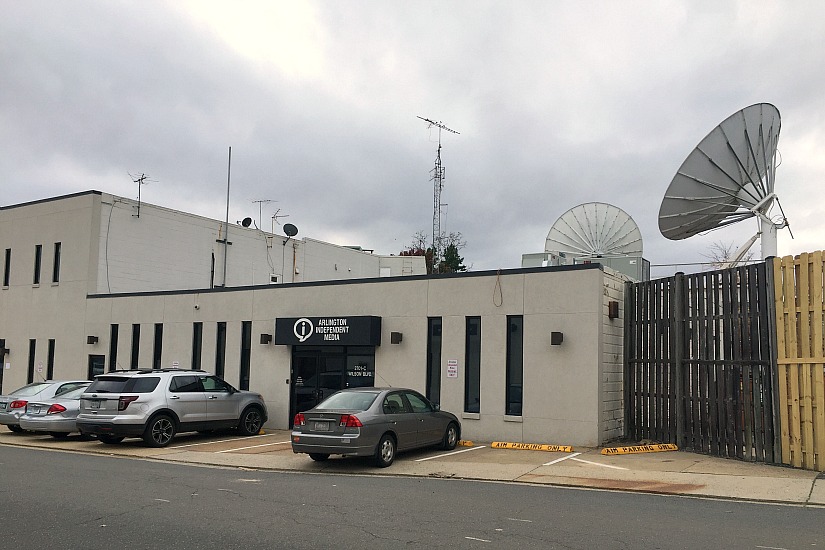
Arlington’s local radio station has been playing the same music on repeat since December.
The continuous lo-fi beats, noted by listeners more than a month ago, are a result of aging equipment and financing delays complicating Arlington Independent Media‘s move into a new office building that is home to a transmitter critical to AIM’s operations.
The nonprofit community media outlet — which has TV and radio programming and offers media training courses — is mid-way through its move from its Clarendon outpost at the corner of N. Danville Street and Wilson Blvd, behind the Beyond Hello dispensary, to a new location at 2300 Clarendon Blvd.
Staff packed up and stored all AIM’s non-technical equipment in its new Green Valley outpost while its TV and radio broadcasting equipment sits in the lobby, awaiting contractors who can rewire it in 2300 Clarendon Blvd, a new space dubbed AIM Live!
It is a point of consternation for Alvin Jones, the station manager for the community media outlet’s radio station, WERA 96.7 FM.
“It’s been frustrating,” he told ARLnow. “I don’t get to hear, when I’m in my car, the great programming 50 producers are putting out.”
Still going strong! @RadioArlington same 1 hour show for 2 months!!! https://t.co/UVu2FrRC6S
— SRtwofourfour (@SRtwofourfour) January 24, 2024
Former radio show producer Bennett Kobb says he has noticed the same music playing since Dec. 1, 2023. The beats are intended as a backup when interruptions arise, whether that is due to a power outage, a delayed DJ or problems with a station computer, he said.
“It is not permitted to broadcast ‘dead air’ for any significant length of time, that is, a radio signal with no content and no station identification,” he said. “Many radio stations have such arrangements in place… But this was never intended to go on for weeks as it has.”
As of Jan. 12, he had not heard of any communications to the public explaining what was going on. AIM did ultimately provide an update that listeners should expect the radio to go silent on Jan. 20, followed by TV on Jan. 24, as a result of the move. The post noted listeners “will continue to hear music through our transmitter on WERA 96.7 FM.”
The reason for the prolonged continuous loop is because the equipment that relayed microwave signals from AIM’s Clarendon location to the transmitter at 2300 Clarendon Blvd went down, says Jones. AIM will not need this equipment once it is set up in the same building as the transmitter. Jones likened fixing it before the move to upgrading the tires on a car just before trading it in for a new vehicle.
AIM originally had until Dec. 31, 2023, to move out but now predicts that full move-out will happen next week. The delays come down to finances, according to Jones and AIM CEO Whytni Kernodle.
They say they are waiting for Arlington County to approve the rest of a funding request from November for Public, Educational and Government (PEG) funds — subscription revenue that the county receives from franchise agreements with Comcast and Verizon.
These funds only cover capital expenses, which include hiring contractors to take down and rewire equipment.

This weekend, the Arlington County Board adopted a new agreement governing how Arlington’s public access station, Arlington Independent Media, can request funding.
AIM has a claim on Public, Educational and Government (PEG) funds that Arlington County receives as part of its franchise agreements with Comcast and Verizon. It competes with Arlington Public Schools and county government initiatives for this pot of money, which is dwindling as people end their cable subscriptions.
The new agreement establishes rules for requesting funds, a heretofore ad-hoc process. It requires AIM to maintain and present a detailed capital budget and make PEG requests only as part of the annual budget process, though emergency requests will be considered.
AIM has to provide a host of supporting documents for PEG requests as well as receipts demonstrating it is not using the funding on salaries, rent and utilities. The county reserves the right to audit the nonprofit’s records or require a third-party audit as often as necessary and will take back PEG funding if AIM uses it improperly.
The agreement was approved as AIM prepares to move its headquarters from Clarendon to Courthouse and, to stay afloat, has furloughed staff and will be selling equipment and memorabilia.
“AIM staff is currently on furlough throughout the holidays and thus only working on critical assignments,” the organization said in an email to supporters today, recapping its annual meeting earlier this month. “This has been structured to minimize producer impact, however we ask for your grace & patience while we transition to our new spaces.”
Periods of unpaid work are not a new issue, according to one source close to a former staff member, who had been asked to work without pay before.
Meanwhile, AIM’s current lease ends at 2701 Wilson Blvd, next to the Beyond Hello dispensary in Clarendon, is up on Dec. 31. The organization will make a new Green Valley satellite location, in a county-owned building at 3700 S. Four Mile Run, its home base until the Courthouse location is set up.
The new “AIMLive!” radio and TV broadcasting space in Courthouse is part of AIM’s goal to have a number of locations across Arlington, “with an eye on a new HQ sometime in the next 2-3 years,” the email said.
Despite the upheavals, Board President-elect Chris Judson remained upbeat in his remarks to supporters.
“This year presents a new beginning after a long effort to reinvent the organization,” he said in an email. “We owe tremendous gratitude to AIM staff for the extensive planning and execution that saw this plan to completion.”
During the annual meeting earlier this month, nonprofit leaders were frank about the organization’s financial status, detailing the furloughs and saying AIM was in survival mode. Still, they dismissed recent criticism over financial management from some people previously affiliated with AIM as a bad-faith attempt to defund the nonprofit.
They also addressed mixed public opinion about the role and importance of a primarily cable TV and radio-based nonprofit going forward, in an increasingly online world. Outgoing board president Demian Perry said he read the comments on ARLnow’s most recent article about AIM and they stung him but they were “nothing new.”
As for the new agreement governing PEG requests, AIM CEO Whytni Kernodle has told ARLnow in several interviews that she has pushed for this document to improve accountability — both for AIM and the county.
“They weren’t giving money to the ‘P’ or the ‘E’ and the PEG. So when I came on board, I recognized that… I’ve been asking for this memorandum,” Kernodle said. “What I’m saying to the county is, ‘You took us out, and now you’re not giving us money, and then you’re acting as though you don’t have to give us money when you have… an ethical obligation to your own public access center.”
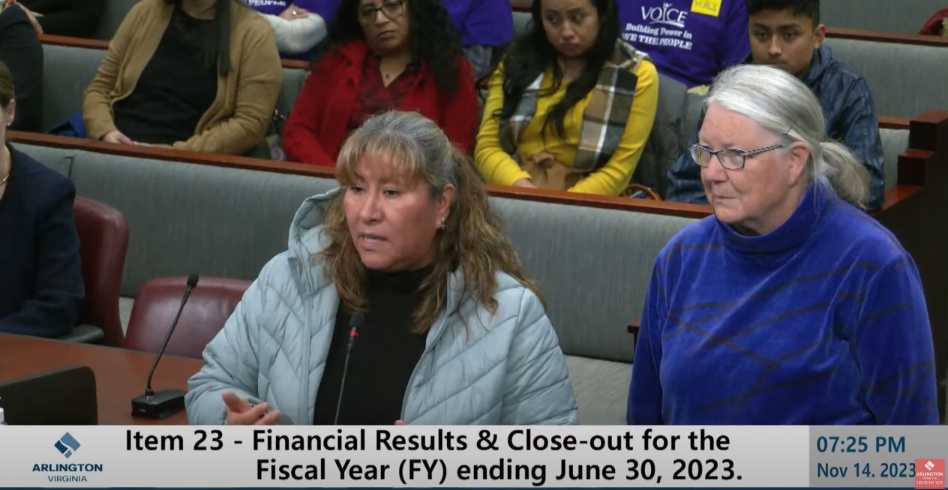
Arlington County is doling out leftover funds from the 2024 fiscal year toward tackling youth substance abuse, public safety and behavioral health challenges it is facing.
Those are three of several buckets that will benefit from the $46.3 million in discretionary close-out funds — almost double what the county had to spend after last fiscal year, $26.9 million. The County Board approved County Manager Mark Schwartz’s spending plan last night (Tuesday).
Some of the bigger-ticket line items are as follows:
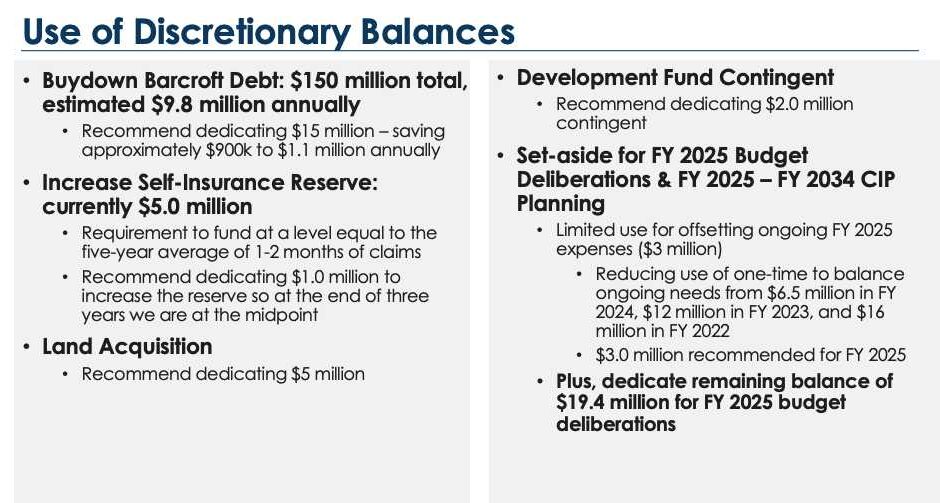
As for public safety, to combat staffing shortages and small recruit sizes for the Sheriff’s Department and the Police Department, deputy sheriffs would get bonuses and ACPD would get money for hiring bonuses that compete with neighboring jurisdictions.
In response to allegations of years of harassment gone unaddressed, levied by several female Arlington County Fire Department employees, the county proposes funding for an Office of Professional Standards, as well as training while an outside law firm conducts interviews about the allegations.
The Dept. of Human Services will get $150,000 for bonuses for hard-to-hire positions. For instance, it has had a hard time finding someone to handle jail diversion programs for adults with serious mental illnesses.
The jail would get an independent medical staff member, as requested by Sheriff Jose Quiroz. Schwartz said the medical staffer would be an independent voice when there are disagreements between state or local clinicians and the jail-based, private medical provider, Mediko.
Sources have previously told ARLnow that the contractor and other jail-based clinicians have disagreed over appropriate drug treatments for inmates, for instance.
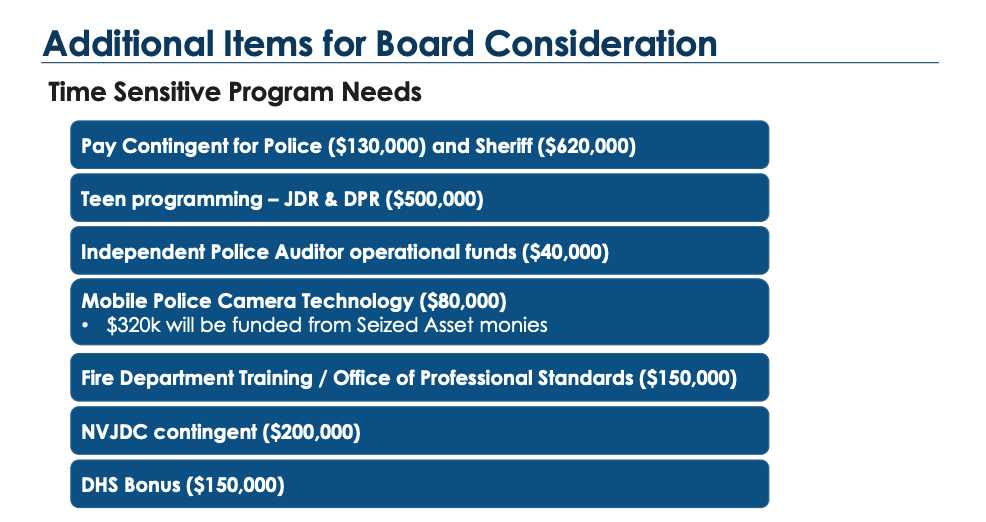
Most discussion centered around $500,000, increased to $750,000, to augment existing teen resources and programs the county, Arlington Public Schools and community partners offer. The parks department and the schools, for instance, have long lists of programs but advocates say many are not marketed to or are unaffordable to the very families hit hardest by the drug epidemic.
The extra funding — responding to community advocacy — would fund work to review and tailor these programs to the substance use and mental health issues teens are facing. In putting forward this suggestion, Schwartz was complimentary of how the schools and the county are working together on the issue.
County Board member Takis Karantonis carried a motion 3-2 to increase the funding to $750,000 so that these activities can happen in the next six months if needed, without staff having to draw from resources somewhere else.
Arlington County Board Chair Christian Dorsey and Vice-Chair Libby Garvey dissented.
“I hate how that could be misinterpreted as not desiring to spend more money on this initiative. It’s not that at all,” Dorsey said of his vote. He noted the extra $250,000 is not earmarked for something specific and that this effort has generated a lot of ideas but no specific plan, yet, deeming the increase “more symbolic than substantive.”
A dozen historical preservation projects across Arlington, from historically accurate home renovations to community-based projects and research, have received county funding through a new program.
The county doled out roughly $256,000 to 12 of the 19 applicants for the inaugural round of the Arlington County Historic Preservation Fund.
This is part of a new effort to give incentives to residents, property owners, developers and community organizations to take on historic preservation work — rather than leaving these efforts and advocacy to the county, the Arlington Historical Society and two citizen commissions.
These entities either have limited ability or few, bureaucratic tools to stem the tide of redevelopment, casualties of which include the historic Febrey-Lothrop house and Fellows-McGrath House.
“From big picture storytelling and research projects to individual building preservation, this inaugural group of Historic Preservation Fund recipients demonstrates the breadth of Arlington’s unique history and many ways we can preserve our story for generations to come,” County Manager Mark Schwartz said in a statement.
A few recipients and projects include:
- The Green Valley Civic Association, which plans to highlight local landmarks that contribute to Arlington’s African-American culture with signs, tours and workshops. It will also be digitizing records and adding more educational resources to its website.
- We Are Barcroft: A 60 Acre History of People & Place, by local artist Sushmita Mazumdar, who plans to chronicle the cultural heritage of the Barcroft Apartments.
- An Arlington Historical Web & Mobile App, administered by Arlingtonian Peter Vaselopulos, where he will publish community histories by local authors, artists and community members.
- The Dominion Hills Civic Association, which will create three historic markers near the former location of the Febrey-Lothrop Estate, or Rouse estate — demolished for new single family homes to the chagrin of local preservationists — so residents and visitors can learn about the site’s “forgotten history” spanning colonial America to the 20th century.
“The grantees represent a wide range of creative projects, several of which have a strong focus on cultural heritage, and we are excited about the opportunity to financially assist these recipients and further the County’s historic preservation goals,” said Historic Preservation Section Supervisor Cynthia Liccese-Torres in a statement.
A review committee selected these projects based on their quality, equity and inclusion, community impact and managerial competence, per a press release.
Most of the grants amounted to $20-25,000 but the two largest grants will help homeowners preserve their Cherrydale and Maywood homes, which are each more than 100 years old. The capital improvement grants will assist the homeowners in taking on what can be dollar- and time-intensive work.
“Historic district renovations often entail meeting specific design and preservation standards to ensure alterations are done in a sensitive manner,” says Rachel LaPiana, a communications specialist with the Department of Community Planning, Housing and Development.

Armed with some federal funding, Arlington County plans to stem stormwater runoff with native plantings and fix leaky sewer pipes that serve thousands of people.
On Saturday, the Arlington County Board accepted a $2.25 million federal grant to be split evenly among three planned projects. These projects, expected to cost some $6 million in total, are intended to reduce runoff into streets and streams, filter pollutants from local streams, and rehabilitate sewer pipes needing serious repairs.
The upgrades, a county report says, will “mitigate the impacts of existing impervious coverage and protect local waterways, and prevent sanitary sewer structural failure, infiltration and inflow.”
(Sewer pipes experience infiltration and inflow when excess water flows in from sources such as stormwater drains and leaky pipes.)
A $750,000 portion of the grant will fund plans to add more native plantings along part of the Gulf Branch stream, near Gulf Branch Nature Center, and to build rain gardens where S. Walter Reed Drive intersects with 6th and 9th Streets S. The projects, aimed at reducing runoff and filtering pollutants from streams and streets, are expected to cost $1 million overall.
The rain gardens on S. Walter Reed Drive will be planted when Arlington makes transportation upgrades on the major road, including upgraded bike lanes and pedestrian crossings.
Another $1.5 million will be split between two sewer rehabilitation projects, expected to cost $5 million overall.
First up is a $2.8 million project to rehabilitate a 5,876-foot section of a 30-inch sanitary sewer between Arlington Blvd and Columbia Pike, serving all of East Falls Church and parts of Falls Church and Fairfax County.
Three years ago, inspectors found many leaking joints in the now-48-year-old sewer, which runs through the Four Mile Run stream valley. These leaks cause groundwater and stormwater to seep into the pipe, contributing to high bacteria levels in Four Mile Run, according to the report.
That also generates wastewater and increases chemical and energy costs at the Arlington County Water Pollution Control Plant downstream, the report said.
The county also proposes to rehabilitate a 2,906-foot section of a large pipe in Rosslyn that the report says “zig-zag[s] between high-rise buildings and through underground parking garages” between N. Lynn Street and the interchange at Arlington Blvd and Richmond Hwy.
“The sewer was inspected in 2016 and many sections were deemed to require immediate rehabilitation due to structural deficiencies which allow for significant infiltration and inflow and could lead to structural failure,” it says, noting this would also generate more wastewater and higher chemical and energy costs at the wastewater facility.
For both sewers, the county first proposes cleaning the pipes. Then, to prevent leaks, a resin liner would be forced against the walls of the pipes, effectively creating a “new pipe encased within the old sanitary sewer,” per the report.
“Impacts such as travel lane closures, trail and sidewalk detours, bus stop relocations, etc. will be communicated in advance to the public following award of the construction contract, as equipment staging and sewer bypass layouts won’t be determined until then,” it continues.
The grants come from the U.S. Dept. of Housing and Urban Development at the request of Rep. Don Beyer, as part of a 2023 spending bill Congress approved last December. The funding applies to expenses through Aug. 31, 2031 and no local match is required.
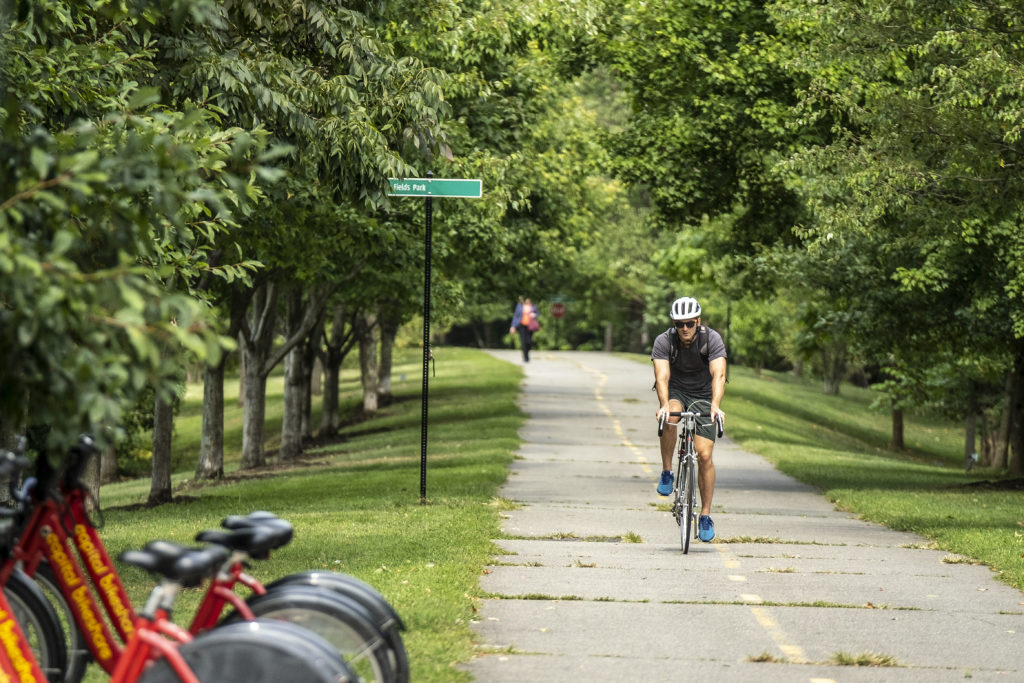
This weekend, the Arlington County Board is set to consider a proposal to funnel nearly $400,000 into the second phase of the Bluemont Junction Trail safety project.
Phase 2 includes moving and updating three trail connectors to be accessible to people with disabilities and improving cyclist and pedestrian intersections between the W&OD Trail and the Four Mile Run Trail on both sides of Wilson Blvd, per a county report.
The plan also calls for resurfacing a 480-foot segment of Four Mile Run Trail and repairing a nearby pedestrian bridge.
The project is part of a multi-year county effort to address poor visibility between trail users and drivers along the Bluemont Junction Trail, which crosses the Bluemont neighborhood and connects Ballston to the W&OD Trail at Bluemont Park. Plans were developed by the county with input from the public and the Bluemont Civic Association, the Bicycle Advisory Committee and the Pedestrian Advisory Committee
In the project’s first phase, which spanned the fall of 2021 to last summer, the county and the Virginia Dept. of Transportation made upgrades to roughly 4,500 linear feet and 13 connector trails, the report said. This included reconfiguring the trail’s intersections with N. Emerson Street and N. Kensington Street.
The second phase, however, demands more “in-depth engineering” than the milling and repaving carried out in the first phase, the report said.
Rep. Don Beyer has earmarked $325,000 in federal funds for the second phase of the project, which has an estimated total cost of $711,662.
The community will have an opportunity to provide input on the designs and proposed improvements if the funds are allocated, a county staff report notes.
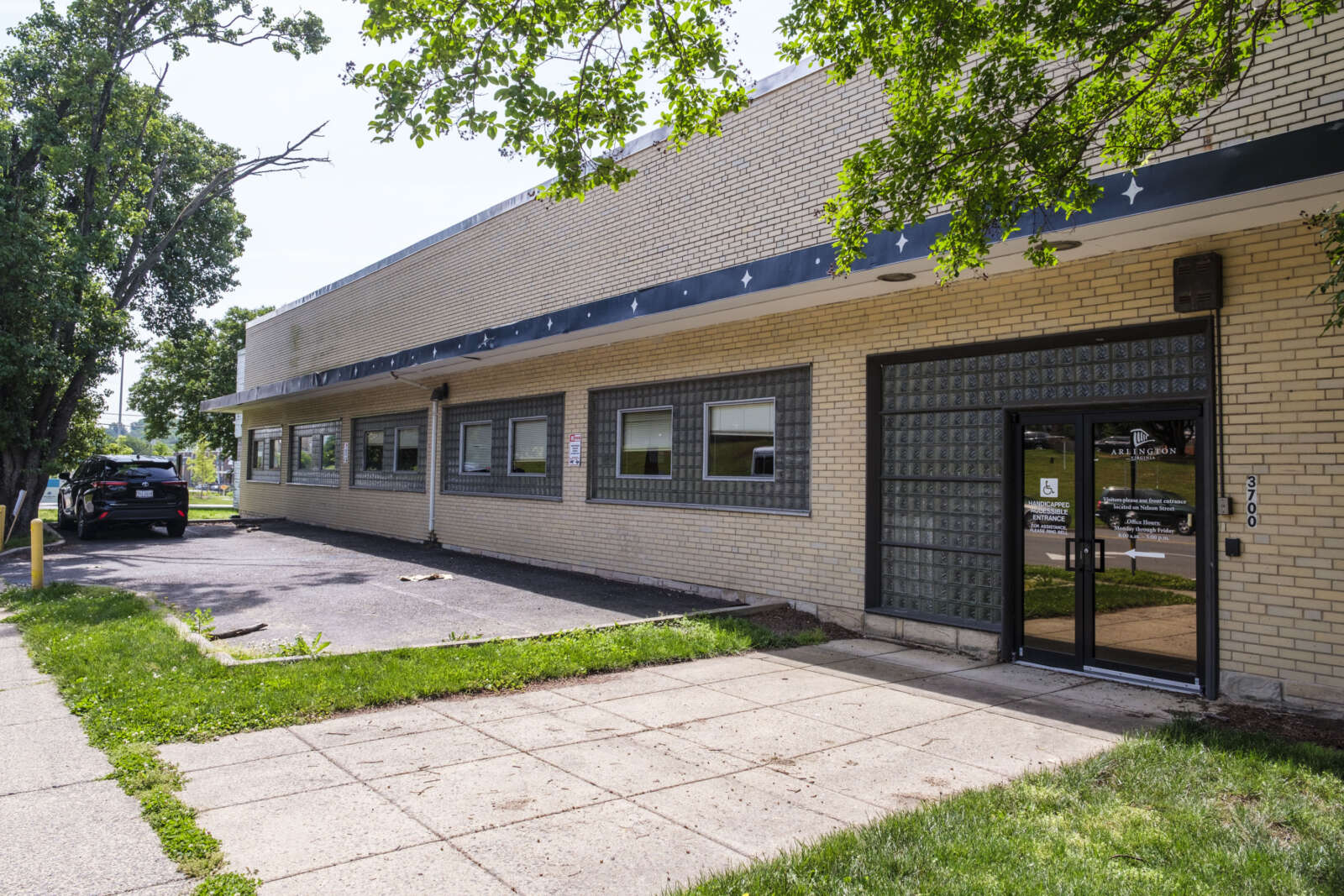
(Updated at 6:30 p.m. on 08/25/23) Arlington Independent Media is seeking sponsors for a free community event it will host early next month.
Arlington’s public access TV channel, its community radio station and a media training provider is throwing its first-ever “MusicFest.” The event, on Sept. 7, from 5:30-10 p.m. at its Clarendon studios at 2701 Wilson Blvd, will have live music, food and drinks and vendors.
Ahead of the event, the organization is seeking individual donations as well as sponsors, who can get perks such as logo placement, free beer and wine and radio announcements on WERA 96.7 FM for contributing $1,000 to $5,000.
The event comes as the Arlington County Board is encouraging the organization to vary its funding sources. The fundraiser coincides with AIM’s 40th anniversary and will “honor our legacy as Arlington’s premier community media center and to celebrate AIM’s exciting future at the forefront of media arts,” per a letter to supporters.
“Arlington Independent Media has witnessed tremendous growth in 2023,” it continued. “We have been continuing the build-out of our new podcast/broadcasting multimedia studios at our South Arlington location, pioneering our new youth-centered journalism initiative, upgrading our cabling system and reimagining our training and membership programs.”
The new studio, located in Green Valley, is set to have a ribbon-cutting on Oct. 20, AIM CEO Whytni Kernodle says. As for the Youth Journalism Initiative (YJI) vaunted in the letter to prospective sponsors, she says 10 students have come through the program. Another 20 participated in a Youth Journalism Club that AIM hosted with Arlington Public Library and 35 attended a camp intended to prepare them for YJI.
Kernodle, who has made a commitment to racial justice part of her mission as AIM’s leader, says the organization is changing its selection process for training programs to uplift marginalized voices. It is also looking to make membership free so people do not feel excluded based on cost.
Next month’s fundraiser could offset the financial impact of striking membership fees and bigger financial headwinds AIM faces. For instance, a once-reliable funding source — a cable franchise agreement, which provides funding based on local cable TV subscription numbers — become increasingly unpredictable.
After years of trying to lessen AIM’s reliance on tax dollars for operating expenses, the County Board approved a 33% increase its support to the organization in the Fiscal Year 2024 budget, giving it $506,579.
Still, the County Board wants AIM to demonstrate it can fundraise and clean up its budget.
The organization’s federal Form 990s are behind schedule and a profit-and-loss document ARLnow reviewed from 2018-2021 shows the organization had lost more than $345,500 between 2018-2020. A copy of AIM’s 2022-23 fiscal year budget, which ARLnow also reviewed, appears to show AIM is working on meeting the Board’s directive.
In all, AIM took in $1.3 million this immediate past fiscal year, which ended in June, up from $564,587 last year. This includes a 30% increase in unrestricted grant funds, a $35,000 increase in revenue from underwriting sponsors, and new revenue from camps and studio fees.
Still, more than half of the $750,000 increase comes from an infusion of “restricted grants” equivalent to the Public, Educational and Government (PEG) funding it logged: $433,054. The sudden infusion, earmarked for capital expenses, came after three fiscal years in which no PEG funds were allocated, per the profit-and-loss statement.

